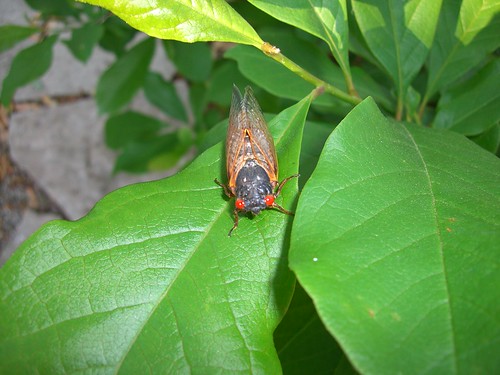 These cicadas spend 17 years underground, living off sap from tree roots. Now is the time when they appear in mass, shed their brown skeletons and mate. Before they die, females will lay the eggs of the batch scheduled to arrive in 2024.
This periodical cicadas swarm technically is called The Great Northern Illinois Brood XIII, they have red eyes instead of green like the annual ones. They can emerge in vast numbers — as many as 1.5 million per acre — in a path about 200 miles long that stretches from northwestern Indiana to Wisconsin.
They don’t bite or sting and their single purpose is to mate, lay about 30,000 eggs and die. The male cicadas’ buzz is so loud they can be heard a quarter-mile away. The racket is a love song. Only the males sing. The females are lured to the sound and fly nearer. A female responds to a male with a flick of her wings. The two gradually draw close to one another until they meet for mating. Male cicadas die soon after mating. Females lay 400 to 600 eggs in as many as 40 to 50 different nests before they die. The billions of cicada nymphs hatch in their nests high in the trees, drop to the ground, and burrow into the earth. There they find a succulent tree root, which they tap into with a special strawlike mouth part. They feed on the tree sap and pass through their various growth stages until, 17 years later, it is time to emerge and renew their life cycle.
National Geographic News explains that periodical cicadas are found only in the United States east of the Great Plains. Seventeen-year cicadas are found mainly in the northern, eastern, and western part of their range.
These cicadas spend 17 years underground, living off sap from tree roots. Now is the time when they appear in mass, shed their brown skeletons and mate. Before they die, females will lay the eggs of the batch scheduled to arrive in 2024.
This periodical cicadas swarm technically is called The Great Northern Illinois Brood XIII, they have red eyes instead of green like the annual ones. They can emerge in vast numbers — as many as 1.5 million per acre — in a path about 200 miles long that stretches from northwestern Indiana to Wisconsin.
They don’t bite or sting and their single purpose is to mate, lay about 30,000 eggs and die. The male cicadas’ buzz is so loud they can be heard a quarter-mile away. The racket is a love song. Only the males sing. The females are lured to the sound and fly nearer. A female responds to a male with a flick of her wings. The two gradually draw close to one another until they meet for mating. Male cicadas die soon after mating. Females lay 400 to 600 eggs in as many as 40 to 50 different nests before they die. The billions of cicada nymphs hatch in their nests high in the trees, drop to the ground, and burrow into the earth. There they find a succulent tree root, which they tap into with a special strawlike mouth part. They feed on the tree sap and pass through their various growth stages until, 17 years later, it is time to emerge and renew their life cycle.
National Geographic News explains that periodical cicadas are found only in the United States east of the Great Plains. Seventeen-year cicadas are found mainly in the northern, eastern, and western part of their range.
Tuesday, May 22, 2007
17-year Cicadas emerge in the Midwest
Subscribe to:
Post Comments (Atom)



No comments:
Post a Comment